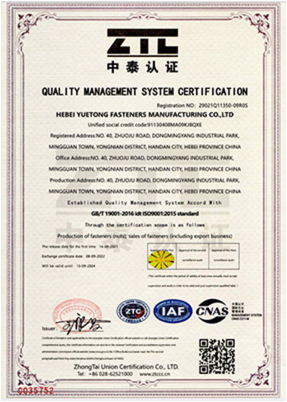8월 . 23, 2024 18:33 Back to list
Understanding the Benefits and Applications of Screw Anchors in Construction Projects
The Importance of Screw Anchors in Construction
Screw anchors are an increasingly popular choice in the construction and engineering industries due to their versatility, strength, and ease of installation. Unlike traditional anchors that require drilling or expansive concrete, screw anchors can be installed with minimal disruption and mess. This article will explore the various types of screw anchors, their applications, and the benefits they offer in modern construction.
What Are Screw Anchors?
Screw anchors, also known as helical anchors or screw piles, consist of a shaft with one or more helical plates, resembling a screw. They are designed to be drilled into various types of soil or substrates, creating a secure hold that can support significant loads. Their design allows them to be installed in difficult conditions, including limited access sites and adverse weather, making them ideal for diverse environments.
Types of Screw Anchors
There are several types of screw anchors, each designed for specific applications. The most common types include
1. Helical Piles Typically used for deep foundation applications, helical piles are ideal for supporting structures like buildings and bridges. They can be installed to various depths, depending on soil conditions and load-bearing requirements.
2. Screw-in Anchors These anchors are primarily used in lighter applications such as securing decks, fences, or signs. Their ease of installation and removal makes them particularly appealing for temporary structures.
3. Micro Piles Similar to helical piles but smaller in diameter, micro piles are used in constrained spaces where traditional piling methods may not be feasible. They provide substantial load-bearing capacity with minimal disruption to the surrounding area.
screw anchor

Applications of Screw Anchors
Screw anchors have a wide range of applications across different sectors. In residential construction, they are often used for securing fences, decks, and patios. In commercial construction, their ability to support heavy loads makes them suitable for foundations, retaining walls, and underpinning existing structures.
Moreover, screw anchors are also utilized in environmental projects, such as stabilizing slopes or protecting against soil erosion. Their adaptability allows for applications in various soil types, from loose sands to dense clay.
Benefits of Using Screw Anchors
The primary advantages of screw anchors lie in their efficiency and effectiveness. They can be installed quickly with minimal heavy machinery, saving both time and labor costs. The self-tapping design eliminates the need for large excavation work, thus reducing the environmental impact.
Additionally, their resistance to lateral loading and ability to accommodate movements in soil make screw anchors a reliable choice for supportive applications. Their durability and resistance to corrosion also enhance their lifespan, further contributing to cost savings over time.
Conclusion
In summary, screw anchors represent a crucial advancement in anchoring technology, offering reliable solutions for various construction challenges. Their benefits in terms of installation speed, adaptability, and load-bearing capacity make them a preferred choice for builders and engineers alike. As construction practices continue to evolve, the role of screw anchors is likely to grow, paving the way for more innovative and sustainable building methods.
-
The Ubiquitous Reach of DIN934 in Application Realms
NewsMay.16,2025
-
Exploring Different Bolt Types
NewsMay.16,2025
-
Cracking the Code of Sleeve Anchor Mastery
NewsMay.16,2025
-
Clamp Design Principles,Types and Innovations
NewsMay.16,2025
-
Artistry Inspired by the Humble Anchor Bolt
NewsMay.16,2025
-
A Deep Dive into Screw Types
NewsMay.16,2025


